Cooperative Resource Generation
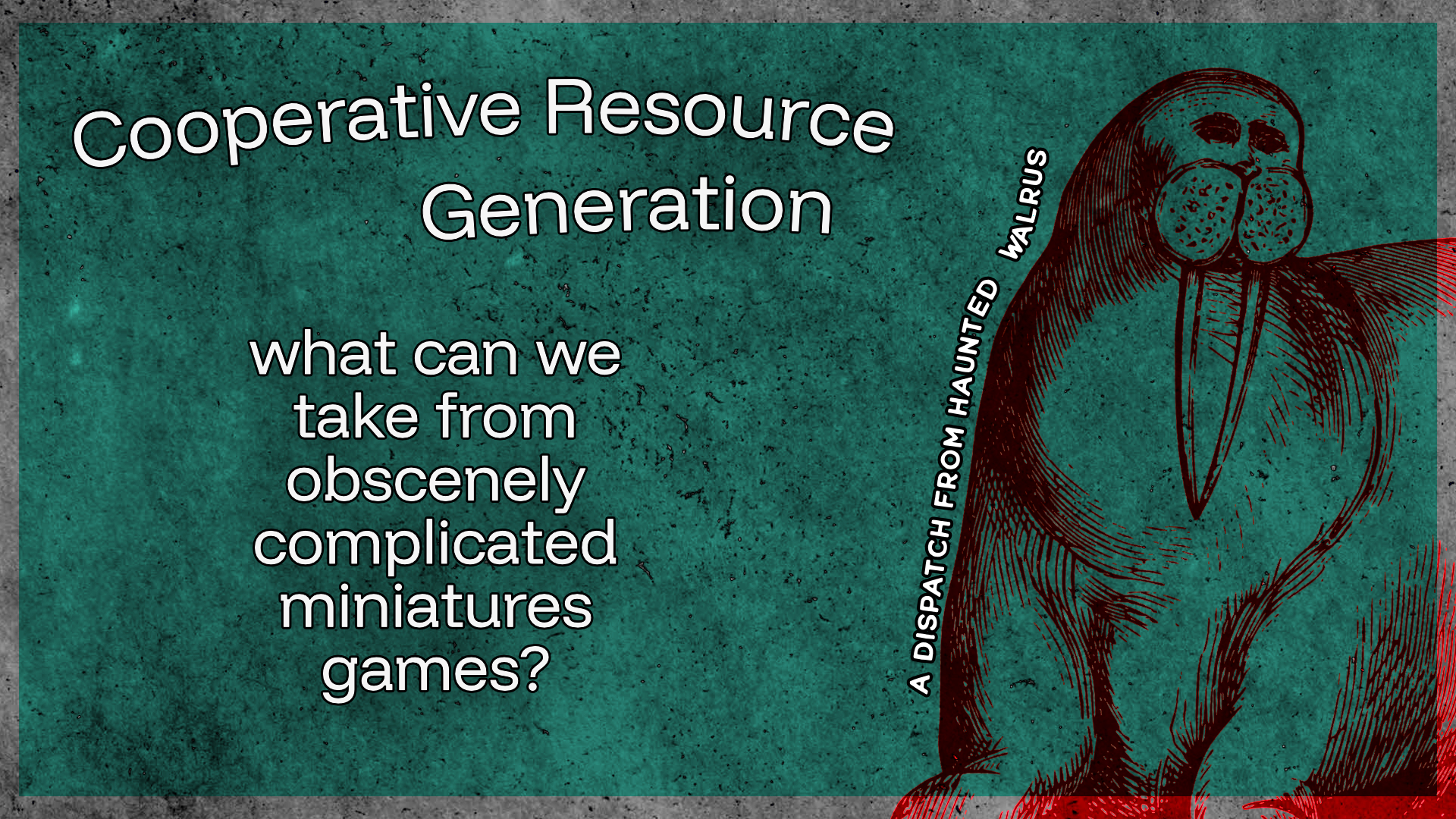
Within the broader niche of “tabletop games” lies an infinitely nesting series of yet-more-niche types of game. You of course have a broad split at the top with the erroneously named Board Games (despite many of them not having boards) and Roleplaying Games (despite many of them not involving roleplaying). Under each of those you could add any number of subcategories, which each have their own subcategories.
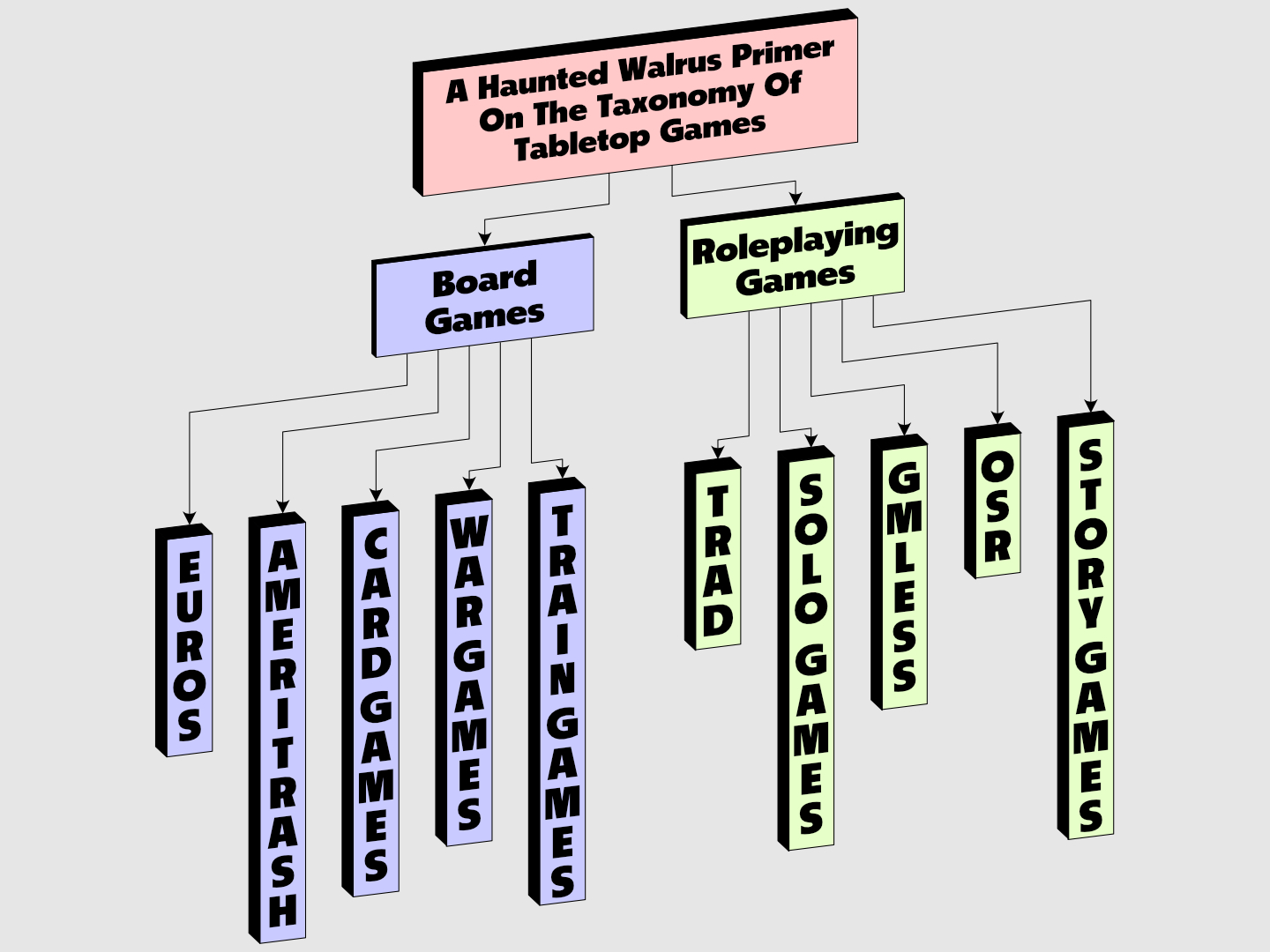
Things get even more complex when you realize that game design is a work of human creativity. No game truly falls into one category as neatly as, say, humans being categorized as primates, mammals, animals, or eukaryotes. Where do you put a game like Above and Below, which is primarily a euro game about collecting resources to build up a little village, but often diverts into light roleplaying where your villagers delve into a cave and read off bits of story?
I like to design games that bridge the board-roleplaying divide by pulling mechanical inspiration from the board game side to create interesting roleplaying games (typically of the gmless or story game persuasion). That’s the core conceit of Haunted Walrus so far, and will be a big feature of my upcoming games. As though from a mirror universe, there’s a whole class that I call obscenely complicated miniatures games that do the opposite: dabble in the trappings of trad roleplaying games to deliver a game that flips between tactical grid-based combat and some kind of exploration or settlement building phase to drive a story towards the next big tactical battle.
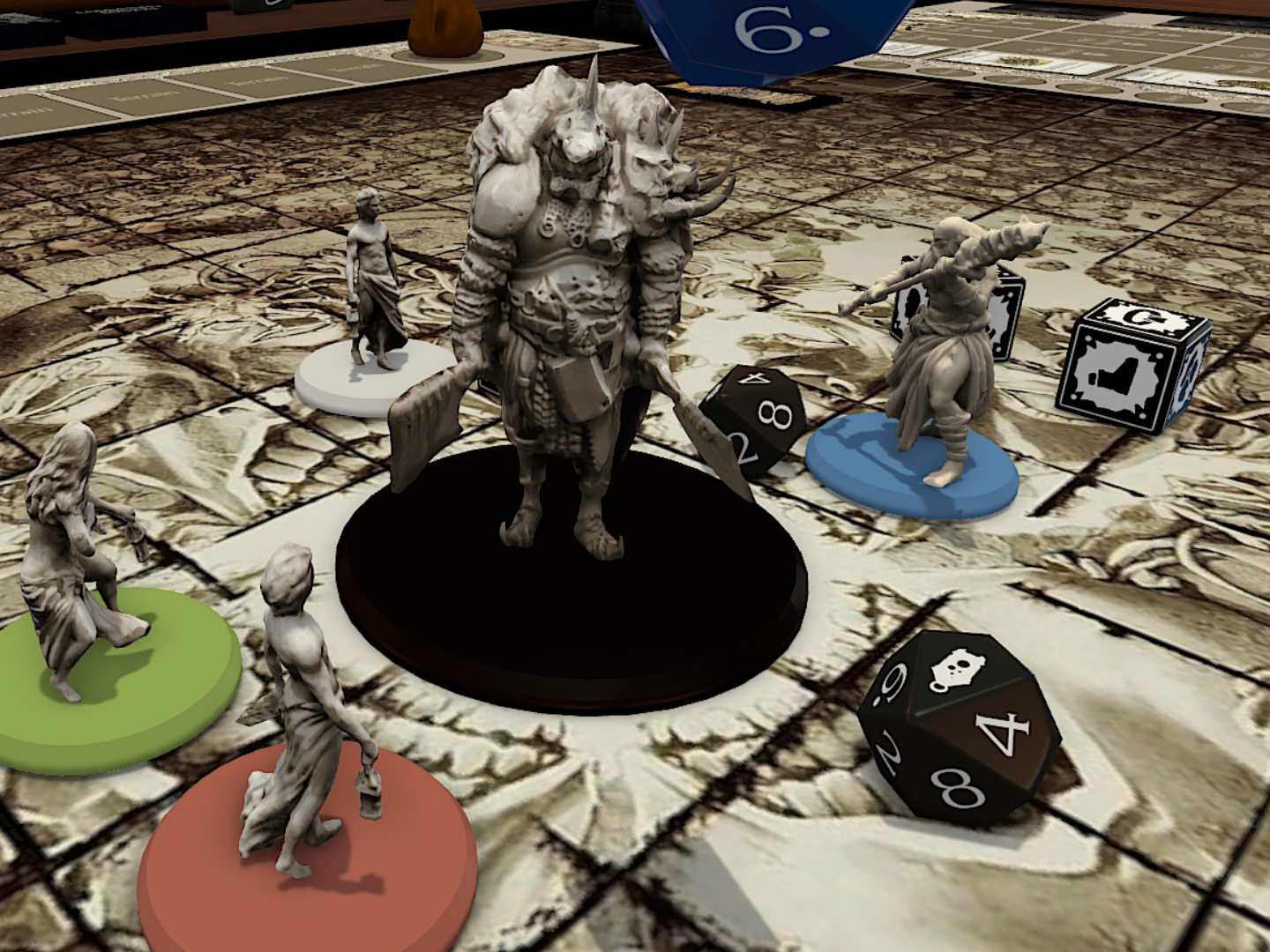
One such game is Kingdom Death Monster. I’ve had the pleasure and misfortune to play quite a few sessions of KDM on Tabletop Simulator recently. It’s a disaster of a game, with more bad ideas than good, but so many ideas that you keep giving it a second chance. I’ll be writing at least one Haunted Walrus going over some of the better ideas in KDM and how playing it has warped my design sense. Not today though. I’m not ready to formally write up my formulation of Burr Theory, or how we should all be making our games a little bit shit to ensure they get stuck in our players’ brains.
Kingdoms Forlorn: Dragons, Devils, and Kings
My KDM group recently set out on a new quest: “pause” our campaign and investigate other obscenely complicated miniatures games to see if they’re all as profoundly frustrating as Kingdom Death. That investigation begins with Kingdoms Forlorn, a true adherent to obscene complexity that raised over a million euros on kickstarter almost 3 years ago. The game itself isn’t out yet, but the studio behind it recently put out a preview version on Tabletop Simulator.
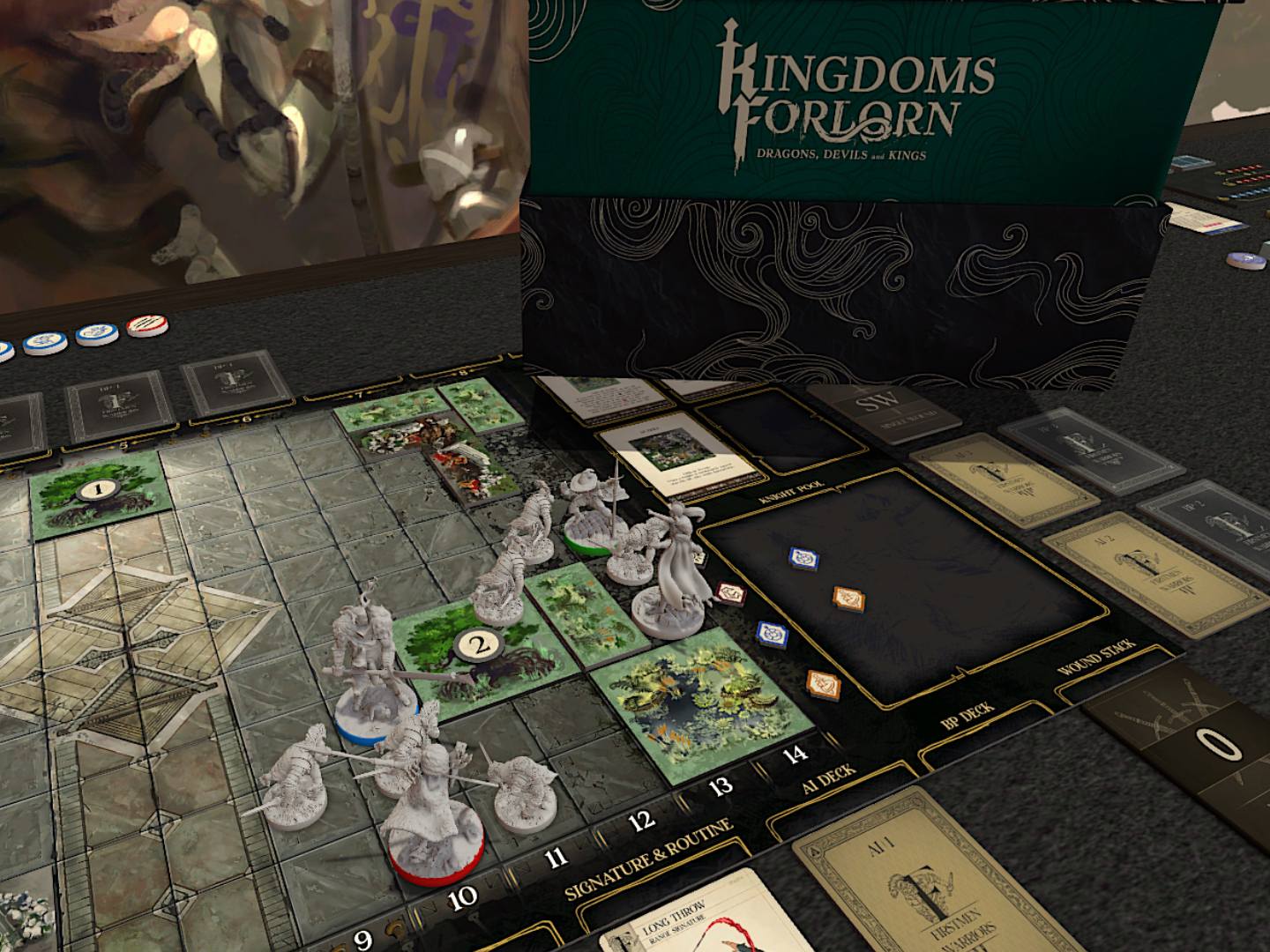
A funny aside about the obscenely complicated miniatures game category is that they’re all really expensive games that do comedy numbers on crowdfunding sites. Backers perhaps assume that if the game is terrible, they get a bunch of cool miniatures to paint so why not drop several hundred dollars sight unseen? The mega-millions nature of these games fascinates and confounds me, but also plays a role in making their rulesets so complex.
If a board game costs you hundreds of dollars, weighs more than your cat, and takes up as much space as tens of delightful little Oink games, you basically want it to be a psychic vortex that will take hours to learn, tens of hours to play, and hundreds of hours to master. It might actually be worse for these games to be as simple as Tok Tok Woodman, as sleek as Splendor, or as elegant as Skull because those games are easy to digest and evaluate. The obscene complexity helps soothe the sticker shock because there’s just so much to chew on that you’re able to convince yourself it’s worthwhile even if it’s not actually good or if you don’t ever figure out how to play the damn thing.
The Knight Pool
One session in, it seems like Kingdoms Forlorn might actually be a good game underneath the layers of complexity. It’s a breath of fresh air compared to KDM’s commitment to being frustrating on purpose, and its many ideas appear to be much more thought through. Each player has a specific knight that they’re playing, and each knight has a book of tales that contain investigations and quests that are only read by that player. There’s a very cool delve phase which is essentially a tile laying game that has the characters explore a kingdom to hunt for clues for their own personal investigations. After the delve goes on for a certain number of turns, you pop over to the tactical board to chow down on the game’s main course.
I won’t describe how the combat works because there’s simply too much going on. You bop around on a grid, draw cards to see how the monster(s) move and act, chuck a bunch of dice, and come close to dying quite often. There are 8 long pages in the rulebook that explain the mechanics of extremely specific keywords; you’ll spend most of your time in combat looking these up.
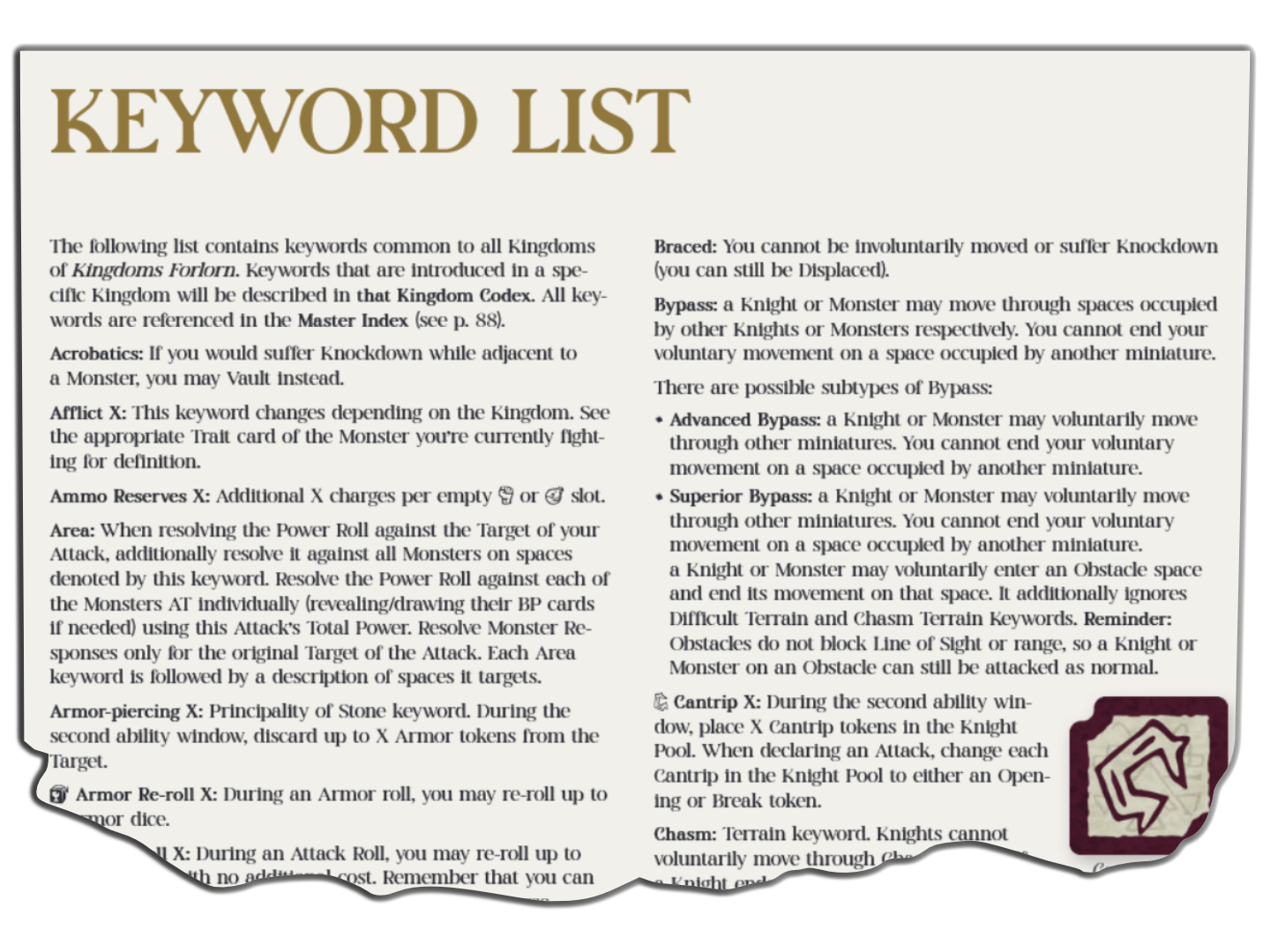
Complexity aside, there’s one mechanic that immediately set off my walrus senses: the Knight Pool. Different abilities and weapons that the players use tell you to add tokens to the Knight Pool, and each of those tokens has a particular use. On your turn, you get to use anything in the Knight Pool that was placed there by the previous player. At the end of your turn, you clear out the pool and add the tokens granted by your abilities and weapons, which the next player uses.
The two main types of tokens you have access to in the preview version of the game are opening and break. Opening tokens let you reroll your to-hit dice, and break tokens convert certain symbols on the damage dice into damage. Fictionally, when you generate an opening token, you distract the opponents for a split second which gives your ally a better chance at hitting. When you generate a break token, you hit them hard enough to weaken their defenses for a moment so that the next hit is more likely to do damage.
The Knight Pool makes you really consider the order that players take their turns in, and I assume it’ll affect character builds in the long run. Maybe you want someone who generates a ton of opening tokens so they can go before the bruiser who does big damage but is bad at actually hitting things. If I’m focusing on a tank build where I can eat a bunch of damage but deal very little, maybe I also try to maximize generating break tokens to up the damage output of my allies.
Three Ideas That Haunt the Walrus
Let’s take a look at three ways we can use abstracted cooperative resource generation in a tabletop roleplaying game. You could implement about a million different versions of this, so as always let me know what you come up with!
Paranormal Investigators
Here’s a game where the player characters are doing some sort of paranormal investigation. The mystery they’re untangling has two components: the paranormal and the mundane. As you poke around for answers, your dice rolls can create two different types of tokens that go into the investigator pool. The first level of token is a lead token, which you can generate by performing some preliminary investigation. Perhaps spending time at the library researching the area’s history could grant you a mundane lead, and doing a phantasmal scan creates a paranormal lead. I’d probably swap them to make it more interesting, and have mundane research grant paranormal leads and paranormal research grant mundane leads to emphasize cooperation between different types of characters.
These leads are spent the next time a member of the team rolls to generate the second type token, the clue. Clues are permanent tokens that give a bonus to every type of roll without being spent, so the truth starts to snowball towards the end of an investigation. I’ll briefly steal from one more board game here (Betrayal at House on the Hill) and say you roll dice each time a clue is generated based on how many clues you now have, and if you hit a certain threshold on that roll, the clue you just gained unlocks the secret of the whole mystery.
This could work as a GMed game, or even as a framework to layer on top of your normal GMed game when players start investigating something. Whenever tokens are generated, the GM will give bits and pieces of the overall mystery to the players. It could also be GMless, where players themselves are creating the details as play goes on. Either way sounds fun to me!
Tiny Puppeteers
Games like Black Mass, Bluebeard’s Bride, and Everyone is John have players share narrative control over different aspects of a single character. In these games, you’ll take turns in the driver’s seat of the character, dictating their actions from the perspective of your version of them. What if we made a game where the players were the different aspects of one character, but had to work together at all times to react to the situations their character finds themself in?
If you made a game like that, you could tweak the Knight Pool to simulate the combined effort of the players. The game would be somewhat turn-based, like a tactical battle game but maybe without the fight (I’ll leave it to you to decide what our shared character is doing in this game). The players all take a turn, then our shared character acts based on that, then the world responds.
When players take a turn, they’ll first coordinate an action plan. What should our character do, and how can we achieve it? Then each player will perform their part of the plan with a dice roll, adding some number of tokens to the action pool. After everyone takes their turn, we see what happens with the shared character using the accumulated tokens in the action pool. How you’d resolve this is wide open; you could arrange the tokens into some kind of pattern that determines the course of action, you could convert the tokens into dice for an action roll, you could treat the tokens like resources the character gets to use to carry out the plan.
Whichever option you choose, the combined efforts of each player turning into a single course of action is the juice here. How do you adapt the plan when the first person fails their roll and we might be short on tokens? How doomed are we if the last person fails and we can’t adjust course at that point?
It’s the World Series
For the third idea, I wanted something competitive. A shared pool can be just as useful in interfering with some opponent as it is in helping an ally. What if we did a sports anime style game about baseball’s World Series? We’ll jump back and forth between dramatic character pre- and post-game scenes, and quick simulations of each game to add more drama. We can abstract the moment-to-moment action (or lack thereof) in a game of baseball to better focus on the exciting narrative between these rival players
My mind is drawn immediately to Mike Fitzgerald’s Baseball Highlights: 2045, a 2 player deckbuilding board game that simulates a series of truly awful baseball games in a future that’s been overrun by cyborg hitters and robot pitchers. I love it. Its design teaches a lot about how much you can shave off in a simulation of a sport without becoming something else entirely. Each game, players play a total of six cards to generate the highlights of that game. Cards perform triple duty, generating offense (putting guys on base), defense (removing guys from your opponent’s bases), and pitching (preventing guys from getting on base in the first place). Every card play is quite dense and abstracted, but somehow it all still feels like baseball.
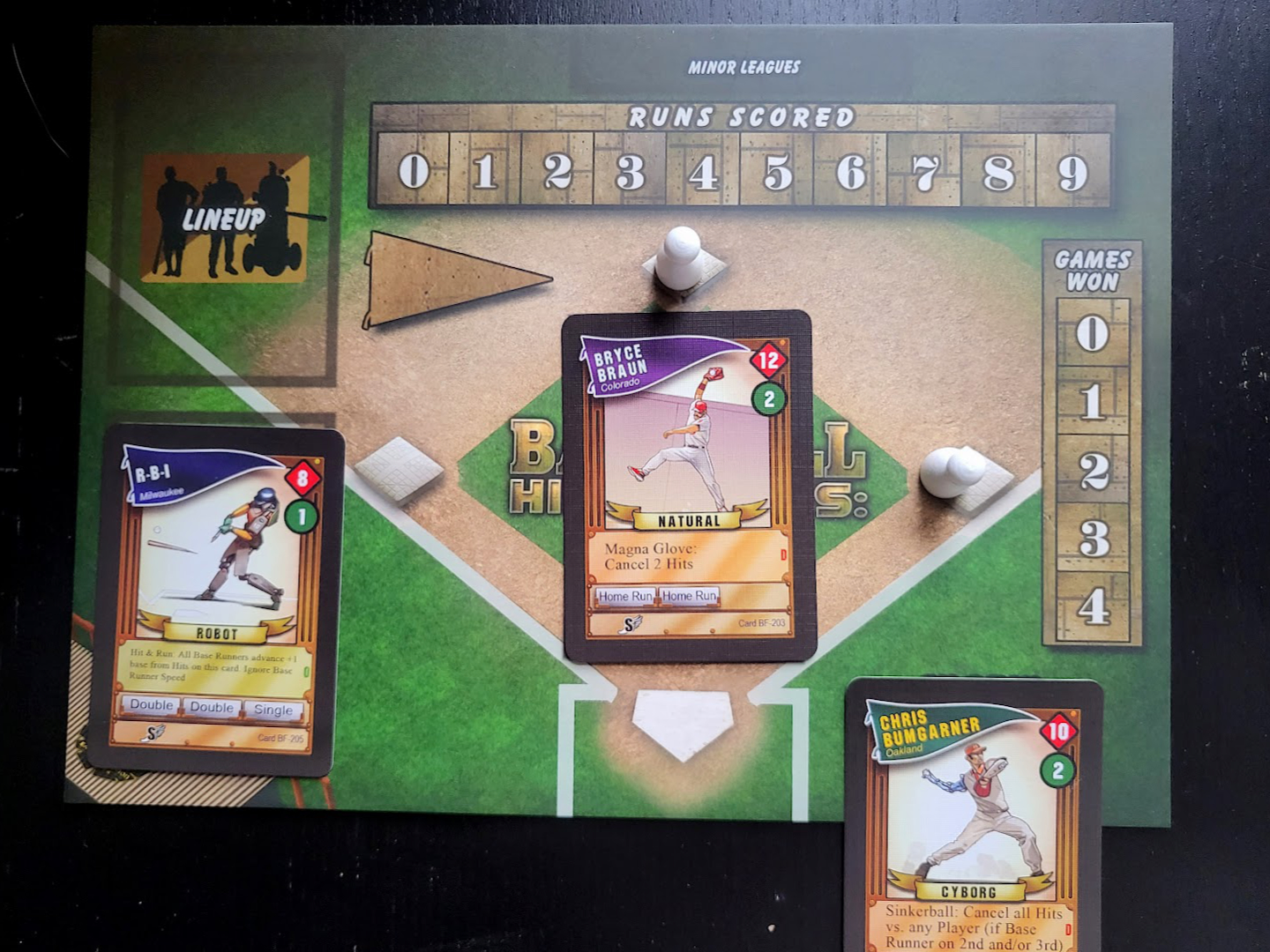
In our game, let’s say each team is made up of a full lineup of 9 characters. Each character will have a field position and four stats: Fielding, Batting, Baserunning, and Impact. The first three correspond to the numbers on a six-sided die. Maybe Bobby Bigman has Fielding[1,2], Batting[3,4,5,6], and Baserunning [-]. Impact tells you how many dice to roll for that character, so we’ll give Bobby Impact (5).
It’s Bobby’s turn in the game. We roll 5 dice for Bobby and get {1,5,4,6,6}. That’s one Fielding and four Batting. Bobby doesn’t do baserunning. This game’s version of the Knight pool is a baseball diamond like the board from Baseball Highlights, but shared by both teams. Each at-bat represents that character’s total contributions to the game. When a character rolls dice, they’ll generate some number of glove tokens, runners, stolen bases, and big moments of their team’s color.
In our example, Bobby generated one glove token, 4 runners, and one big moment (from the pair of 6s; just trust me). Big moment tokens can be spent later to add a die to one of your at-bats, or subtract one from an opponents. Glove tokens can immediately cancel an opposing baserunner, or stay on the field to prevent the next runner from reaching in the first place. Runners get added to the bases and advance everyone that’s already there (baseball style). The catch though, is that the opposing team might have people on base already, so you’ll want to cancel them out with gloves before moving your own guys around the bases. Bobby is a big impact bat, and thus scored his first runner and loaded the bases for the next turn. The other team better send out someone with a big glove to clear the bases before all of Bobby’s runners score.
These games shouldn’t take long to evaluate, but should give a bunch of great character moments to incorporate in the time between games of the World Series. You’d play out the whole best of 7 series, probably with fun scene prompts in the middle. If I flesh out any more, it’ll feel like I’m actually designing this game. My WIP stack is plenty full at the moment, so I’ll leave it to you.
That’ll Do It
Thanks for reading another Haunted Walrus! Please accept my humblest apologies for missing last week, it was quite hectic and I ran out of ideas for the article I was writing. I think I’ve decided that this newsletter is mostly weekly, intended to come out on Thursday afternoons, but if I don’t get the thing done and sent out before Saturday I’ll just skip that week. So look forward to another one next week, and let me know your thoughts below! Make sure to subscribe subscribe to the email list or RSS feed to get the next one!
Get Haunted Walrus
Haunted Walrus
Writings on board games, rpgs, and their mechanics
| Status | Released |
| Category | Physical game |
| Author | adambell |
| Genre | Role Playing |
| Tags | blog, Board Game, Game Design, newsletter |
More posts
- Worker Placement & Uneasy Lies the HeadApr 22, 2025
- Contract Bidding in TarockFeb 14, 2025
- Let's Lie To Each Other For FunJan 23, 2025
- Don't Look At Your HandJan 16, 2025
- Welcome to Haunted Walrus!Jan 15, 2025
Comments
Log in with itch.io to leave a comment.
Great stuff as ever Adam! I really like the idea of a shared resource pool in general, and tokens endlessly fascinate me with their potential.
Your second idea, Tiny Puppeteers, reminded me somewhat of the Inside Out movies. I could imagine the different feelings trying to do what they think is best, and coming together to get their human through.
The thing with those movies though is that it’s the lives of the feelings that get a spotlight more than the human, so I’d need to think of a way to make that dynamic more central… 🤔
Keep up the awesome work, as regularly or irregularly as feels enjoyable!
Big fan of this kind of crossover/comparative work